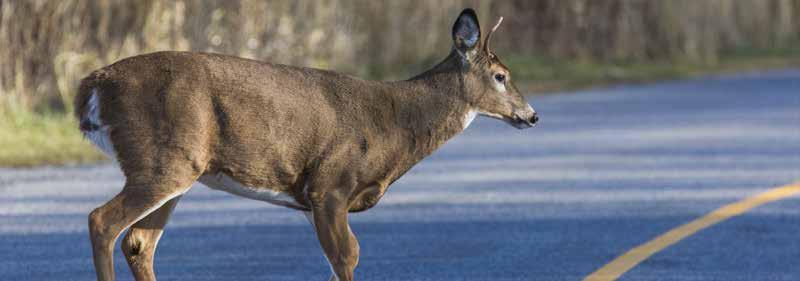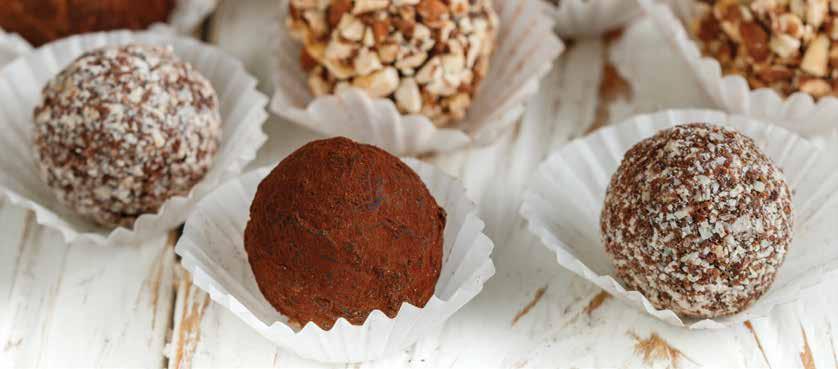
11 minute read
Oh, Deer! Wildlife Safety
from FF December 2021
by Forsyth Mags
Encountering wildlife in nature can be a beautiful spectacle. Vehicles on rural, country roads often witness deer running and jumping or turkey flying or waddling in their natural environment. In seconds, however, an unsuspecting driver, who discovers they are in the path of a creature, may swerve or hit the breaks in panic, leading to a devastating outcome. As drivers, we must be aware that animals are forced from their dwindling woodland homes to meander onto residential streets and highways, placing them in a path of moving vehicles. Fall through winter, drivers need to be vigilant and remember to adhere to the following safety suggestions.
WATCH THE SIGNS
Advertisement
In North Carolina, drivers are unlikely to find a “Wildlife Warning Sign” which is bright yellow and diamond-shaped along the roadside; yet, they do exist! Signs indicate the location of high-risk collision areas, however, without the notification, drivers can become aware of other warnings. For instance, if you are between a dense population of trees, such as a back-road or highway, begin by decelerating, turn on high beams if alone and watch for movement. As a result, drivers are more likely to spot wildlife at a distance!
ADDITIONAL RECOMMENDATIONS: • Rather than keep your eyes straight ahead, scan both sides of the road frequently. • Look for shining eyes! • Be aware of reflectors near roadsides that appear and disappear. • Flashing lights from oncoming motorists, warning of danger ahead.
Studies conclude many wildlife vehicular accidents occur when experiencing ideal conditions such as dry, straight stretches of road on a clear night.
DUSK TO DAWN
Nighttime may appear as the ideal time to travel, believing fewer vehicles are on the road thus allowing you to reach a destination quickly. Between October to early January, deer and other animals seeking mates are active and usually travel in large packs between 6-9pm. Drivers susceptible to the effects of white noise and darkness are often unable to react in time to prevent a collision.
THE BEST STRATEGIES ARE:
Oh, Deer!
WILDLIFE SAFETY
BY LISA S.T. DOSS
bears, will travel long distances seeking locations where food is present, therefore, slow down when driving past the highway and rest stop exits. • Keep a towel and glass cleaner on hand to maintain clean headlights and windshield. • Determine if your headlights are bright enough; if not, reference your car manual to consider upgrading to a slightly higher wattage. (Check your car manual for information.)
HOW TO AVOID A COLLISION
Unexpected accidents do happen; yet, the driver’s action may only result in structural damage to a vehicle. Rely on what’s in hands reach, such as hitting the horn in a series of short bursts or consider flashing bright lights, whenever possible, to deter sighted animals from traveling in your pathway. This action also alerts other drivers of the danger. • Try and remain calm! • Wear your seatbelt; especially encourage passengers in the second and third row. • If an impact is coming, it’s best to release your brakes, preventing the hood from lowering and resulting in an animal to lift and hit the windshield.
• Remain in your lane! • Instruct all passengers to lean away from the vehicle’s center. This one action can keep interior bodies safe should an animal roll over the roof and force its collapse. • After a collision, never touch an injured animal; instead, pull off to the side immediately and call the police directly. While most drivers neglect to report wildlife accidents, the written report of an officer can help insurance claims and out-of-pocket expenses. Reach out to your agent to learn if your insurance covers wildlife collisions. It may be vital to add comprehensive coverage to your policy.
GOALS FOR NC WILDLIFE FEDERATION
North Carolina maintains a staggering 80,000 miles of highway. Elk, black bear, white-tailed and other species of deer are not the only creatures wandering through our beautiful state; dogs, squirrels, snakes, turtles, birds and a diverse insect population also become victims on and along the road. The NC Wildlife Federation works tirelessly to advocate for wildlife crossings, which support natural, pollinating-friendly areas to deter animals from roads. Building bridges to restore and enhance habitats are continuing projects throughout urban and residential areas. Start today by having a family discussion about wildlife safety! Young drivers ranging in age between 16 and 24 are most susceptible to vehicle collisions with wildlife. By knowing and sharing the facts and strategies, you are helping to prepare friends and family for the unexpected dangers on the road!
St. Patrick’s Day Treats
BY KRISTI JOHNSON MARION & EMILY DODSON
Easy No-Bake Christmas Truffles

Tins of Christmas cookies and candies are popular gifts for neighbors, teachers, friends, and to have on hand for family and guests. These no-bake timesaving truffle balls are crowd-pleasers and an easy staple to add to your baking menu, and the kids can easily help. There are lots of variations you can make if you’d like to continue the trend! Consider using lemon cookies and lemon extract instead of sugar cookies and vanilla for the first recipe, to create Lemon Truffle balls. Or consider replacing the sugar cookies with Oreos for Oreo truffles and top with Oreo crumbs. Or Snicker Doodle or Gingersnap Truffle Balls topped with a dash of cinnamon. The possibilities are endless!
NO-BAKE SUGAR COOKIE TRUFFLES NO-BAKE CRISPY PEANUT BUTTER BALLS
INGREDIENTS:
15 sugar cookies (crisp, not soft) 2-3 oz. cream cheese, softened ½ tsp. vanilla extract 1.5 cups white melting wafers Red, green sprinkles
DIRECTIONS::
1. Chop the sugar cookies in a food processor or blender into fine crumbs.
2. Add the vanilla extract and softened cream cheese until combined. (For extra festive color, add sprinkles to the mixture as well!) 3. With your hands, roll the mixture into 1-inch balls and place onto a parchment paper-lined baking sheet. Freeze until firm, about 20 minutes.
4. In a microwave-safe bowl, melt the white chocolate wafers at 50% power until smooth. Place a truffle on a fork and dip into the melted chocolate. Tap away the excess chocolate on the side of the bowl and place on wax paper. Work fast! 5. While the chocolate is still wet, add sprinkles, working fast before it hardens.
TIP: Draw a circle around the truffle with a toothpick before it hardens for a “neater” truffle without the excess chocolate splatter. 6. Refrigerate until serving or freeze ahead in freezer bags for up to 2 months.
First, freeze on a baking sheet for 30 minutes before bagging so they don’t stick together.
CHOCOLATE CHIP COOKIE DOUGH BALLS
INGREDIENTS:
1/3 cup butter, softened 1/3 cup light brown sugar 2/3 tsp. vanilla extract ½-1 cup all-purpose flour ½-¾ cup milk chocolate chips 2 cups semisweet chocolate chips or chocolate melting wafers Coarse sea salt, sprinkles, or chopped nuts for topping
DIRECTIONS:
1. Line a baking sheet with wax paper. In a bowl, mix sugar, butter, and vanilla. Slowly mix in ½ cup flour, adding more until it reaches “cookie dough” consistency. Stir in desired amount of chocolate chips.
TIP: if cookie dough mixture becomes too crumbly, add ½-1 Tbsp. milk to mixture. 2. With your hands, roll dough into 1-inch balls and place on baking sheet. Freeze 15-30 minutes. 3. When dough is firm, in a microwave-safe bowl, melt the chocolate chips or melting wafers in the microwave at 50% power until smooth. 4. Place a truffle on a fork and dip into the melted chocolate. Tap away the excess chocolate on the side of the bowl and place on wax paper. Sprinkle with sea salt, nuts, or sprinkles. 5. While the chocolate is still wet, add salt, sprinkles, or nuts, working fast before it hardens. Tip: Draw a circle around the truffle with a toothpick before it hardens for a “neater” truffle without the excess chocolate splatter. 6. Refrigerate until serving or freeze ahead in freezer bags for up to 2 months. First, freeze on a baking sheet for 30 minutes before bagging so they don’t stick together.
INGREDIENTS:
1.5 cup peanut butter, creamy 2 cups crisp rice cereal 3 cups powdered sugar 2 cups dark chocolate chips (or white if you prefer) ½ cup butter sprinkles or chopped nuts for topping
DIRECTIONS:
1. In a mixing bowl, mix peanut butter and butter until combined, then beat in the powdered sugar until smooth. Stir in crispy rice cereal by hand.
2. Line a baking sheet with parchment paper.
Scoop the mixture into 1-inch balls and place on parchment paper. 3. Chill the peanut butter balls either 1 hour in refrigerator or 30 minutes in freezer. 4. In a microwave-safe bowl, melt the chocolate for 1-2 minutes at 50% power until smooth, stirring at 30-second intervals. 5. Place a truffle on a fork and dip into the melted chocolate. Tap away the excess chocolate on the side of the bowl and place on wax paper.
Sprinkle with sea salt, nuts, or sprinkles. 6. While the chocolate is still wet, add sprinkles or nuts, working fast before it hardens. Tip:
Draw a circle around the truffle with a toothpick before it hardens for a “neater” truffle without the excess chocolate splatter. 7. Refrigerate until serving or freeze ahead in freezer bags for up to 2 months. First, freeze on a baking sheet for 30 minutes before bagging so they don’t stick together.
Sharing the Christmas Spirit
Embrace Ears and Warm Hearts with Christmas Carols and Holiday Songs
BY SUSAN B. B. SCHABACKER
This is the ideal time to make the most of your love of music and Christmas songs. Volunteer to sing Christmas carols for veterans, kids with cancer, the elderly, the homeless—and for anyone whose spirits you want to lift. And, if you are musically inclined and want to take a creative approach, try recording songs, either original songs you create, or songs in the public domain. Here is a list of places to sing, and tips and tidbits about recording your own Christmas and holiday songs!
Where to Share Christmas Carols
‘Tis the season of giving! Spread the cheer right here in your community. Here are some places that would love to have you share the joy of Christmas song and cheer. Calendars fill up fast, so contact these sources right away to schedule a time.
Nursing homes come first to mind, and domestic violence, women’s, and homeless shelters would love the merriment. You can bring cheer to food banks, kids’ hospitals, veterans’ organizations, health facilities, churches, your own neighborhood, and even businesses on their lunch break.
When choosing the songs you’ll sing, make sure to tailor them to your target audience Though everyone can benefit from uplifting music therapy, some age groups might prefer the timeless classics, while other age groups might enjoy more trendy versions. Sometimes thinking outside the box makes sense. For example, “Rudolph the Red-Nosed Reindeer” and “Frosty the Snowman,” are some kids’ favs, but can also be enjoyed by the elderly—kids at heart of any age.

Christmas Caroling Tips & Tidbits
• Remember, harmonies can complement a song.
• Musician friends and the musically inclined can join in and play their instrument(s) of choice.
• Consider adding choreography for a visual element of movement.
• Dress warmly and be brightly festive.
• Stay hydrated and bring a canteen of cocoa and healthy snacks, such as clementines or nuts.
• Be sure to warm up your instrument and your voice before the show.
• Provide percussion, such as jingle bells, tambourines, and shakers.
• Arrive with handouts and goodies. Holiday greeting cards, handwritten notes, inspirational quotes and/or mini-candy canes work well. The 411 on Public Domain, Cover, and Original Holiday Songs
A memorable way to capture your Christmas and holiday song(s) is by recording. But, before you head to the studio or record at home, make sure you know what’s what about copyright issues, since inadvertent violation of copyright issues could come at a cost.
As a local singer/songwriter/musician, I have experienced the realm of PD (public domain) to be an exciting discovery for me. When recording a PD song, you own the copyright to your original arrangement of the recording, but not to the underlying composition. When recording and performing a PD song, you are NOT required to obtain what is called a “mechanical” or “synchronization” license.
Here’s a short list of Christmas PD songs provided by the online music aggregator, CD Baby:
• “Angels We Have Heard On High”
• “Away In a Manger” • “Deck the Halls”
• “God Rest Ye, Merry Gentlemen” • “Good King Wenceslas”
If recoding a cover song, however, you are required to obtain a “mechanical” or “synchronization” license, since someone else owns the copyright. Audio-only recordings for CDs require a mechanical license, and a synchronization licensee is required for video format, such as YouTube videos. Copyrighted songs limit what you can do stylistically and lyrically and your version of the recording must not mispresent the original recording. To obtain a mechanical or synchronization license, you need to negotiate directly with the copyright holder, a process which can be long and complex.
With your own original song, however, you have full artistic license. You can make your songs as traditional or modern in sound and style as you like. The sky’s the limit with originals, and it’s up to you to protect your own original material by copyrighting your lyrics and submitting them to a performance rights organization such as BMI, ASCAP, and SESAC.
Embrace ears, lift spirits, and bring joy to hearts. Share your passion for merry music making as you give generously with Christmas carols that brighten the holiday season!










